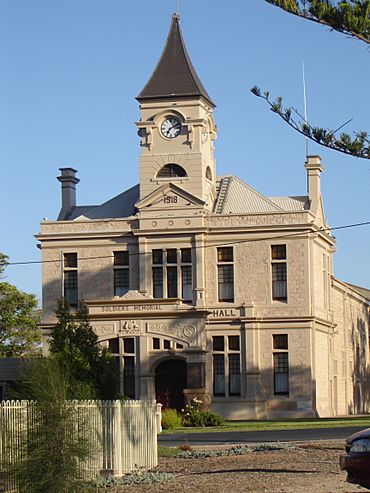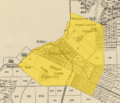Wallaroo, South Australia facts for kids
Quick facts for kids WallarooSouth Australia |
|||||||||||||||
|---|---|---|---|---|---|---|---|---|---|---|---|---|---|---|---|

Wallaroo Town Hall
|
|||||||||||||||
| Established | 1851 | ||||||||||||||
| Postcode(s) | 5556 | ||||||||||||||
| Elevation | 44 m (144 ft) | ||||||||||||||
| Location | 160 km (99 mi) NNW of Adelaide | ||||||||||||||
| LGA(s) | Copper Coast | ||||||||||||||
| State electorate(s) | Narungga | ||||||||||||||
| Federal Division(s) | Grey | ||||||||||||||
|
|||||||||||||||
|
|||||||||||||||
| Footnotes | Adjoining localities | ||||||||||||||
Wallaroo is a port town in South Australia. It is on the western side of the Yorke Peninsula. Wallaroo is about 160 kilometers (100 miles) northwest of Adelaide.
It is one of three towns known as the "Copper Triangle". These towns are famous for their history of copper mining. People also call this area "Little Cornwall". The other two towns are Kadina (8 km east) and Moonta (18 km south). In 2016, about 3,988 people lived in Wallaroo.
Contents
What is Wallaroo Like?
Wallaroo is located near Moonta and Kadina. The land north of Wallaroo is called Wallaroo Plain. South of Wallaroo is Warburto. The name Warburto comes from a local spring. The Narungga people had a name for this spring.
Wallaroo's History
Who Lived Here First?
The Narungga people are the original owners of the land. This includes the area now called Yorke Peninsula. The name "Wallaroo" comes from their language. It comes from wadlu waru, which means "wallaby urine". Early settlers tried to say "Walla Waroo". But they shortened it to Wallaroo. This was easier to write on wool bales. The Narungga people were healthy when Europeans first arrived. Their numbers have since gone down.
When Did Europeans Arrive?
Matthew Flinders was the first European to see Wallaroo. He sailed by on March 16, 1802. He wrote that the coast was "low and sandy". But a few miles back, the land was higher. It had small trees.
Robert Miller first settled Wallaroo in 1851. He was a sheep farmer. In 1857, Walter Watson Hughes bought the land. He named it "Walla Waroo". Later, the name became Wallaroo.
Copper was found nearby in 1859 in Kadina. More copper was found in Moonta in 1861. The famous Wallaroo Mines were actually in Kadina. Wallaroo itself did not have copper mines. Instead, it became a town for smelting copper and a busy harbor.
The Copper Smelter and Port
The copper smelter started in 1861. Wallaroo town was officially created in 1862. The smelter grew very large. It became the biggest copper smelter outside of Wales. Besides copper, it also made gold and lead. It even had a factory for sulphuric acid. This made it a very important producer in Spencer Gulf.
A jetty was built in 1861. Ships used it to bring in coal, timber, food, and mining tools. The first refined copper was shipped in 1862. By 1868, over 100 tons of copper were made each week.
Wallaroo was connected to Kadina by a horse-drawn tramway in 1862. It connected to Moonta in 1866. By 1865, Wallaroo had 3,000 people. In 1874, Wallaroo became an official town. A railway line to Adelaide was finished by 1880.
The town's population reached 5,000 in 1920. Wallaroo was Yorke Peninsula's most important port. But copper production stopped in 1923. An automatic grain loader was built on the jetty in 1958. It is still used today. The railway lines were closed in the 1990s. Today, Wallaroo is still a major grain port.
Important Historic Places
Wallaroo has several places listed as historic sites. These include:
- The Wallaroo Customs House on Jetty Road.
- The Wallaroo railway station on John Terrace.
- The Old Wallaroo Police Station and Dwelling.
- The Wallaroo Courthouse on Lydia Terrace.
- The Wallaroo Wesleyan Methodist Church on Stirling Road.
- The Wallaroo Smelters Site.
Wallaroo's Weather and Location
Wallaroo is in an area where farmers grow grain. It gets a moderate amount of rain. The town is right on the coast, 13 meters above sea level. Wallaroo has a dry Mediterranean climate. This means it has warm, dry summers and mild, wet winters. Temperatures are a bit warmer than in Adelaide. In summer, a cool sea breeze often makes hot afternoons more comfortable.
Local News and Publications
Wallaroo used to have several newspapers. One important paper was the Wallaroo Times. It changed names several times:
- Wallaroo Times and Mining Journal (1865–1881)
- Wallaroo Times (1882–1888)
- Kadina and Wallaroo Times (1888–1966)
- Kadina, Wallaroo and Moonta Times (1966–1968)
- Yorke Peninsula Country Times (1968–present)
Wallaroo's Economy
Wallaroo was once part of the "copper triangle" mining area. A large mining chimney called the 'big stack' still stands. The old copper smelter is now a place tourists can visit.
Since the 1880s, farming has been very important. Farmers grow barley, wheat, and other crops. Wallaroo is a major seaport for South Australia. Many farm products from Yorke Peninsula are shipped from here. This includes seeds and grain from the Wallaroo Grain Terminal.
Tourism is also a big part of Wallaroo's economy now. People visit for the copper mining history and water activities. The three-day Kernewek Lowender Cornish festival happens every two years in May. Kadina, Moonta, and Wallaroo each host one day of the festival.
New houses have been built near the beaches since the 1990s. The Copper Cove Marina started being built in 1997. When finished, it will have 154 boat berths. It will also have new homes and shops. This marina is almost one-third the size of the original town.
Getting Around Wallaroo
Wallaroo is at the end of the Copper Coast Highway. It is also on the Spencer Highway. Old railway lines closed in the 1990s. Grain is brought to the storage area near the wharf by road. Then, conveyor belts load it onto ships at the Wallaroo jetty.
The jetty is also a great place for scuba diving. The water is only 5–6 meters deep. This means snorkelers and free-divers can enjoy it too.
A ferry sometimes runs between Wallaroo and Lucky Bay. Lucky Bay is near Cowell on Eyre Peninsula.
The nearby Kadina Airport is used for small planes and emergency services. There are no regular passenger flights there.
Famous People From Wallaroo
Some notable people have connections to Wallaroo:
- Caroline Carleton, who wrote "Song of Australia".
- Adam Goodes, a famous Australian rules football player.
- Sir Walter Watson Hughes, who helped start the University of Adelaide.
Images for kids
-
Foreshore with silo










